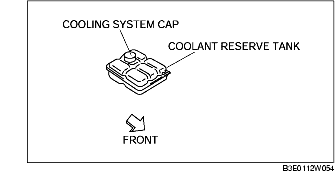
1. Remove the cooling system cap.
2. Remove the under cover.
3. Loosen the radiator drain plug and drain the engine coolant into a container.
4. Flush the cooling system with water until all traces of color are gone.
5. Let the system drain completely.
6. Tighten the radiator drain plug.
7. Referring to the following chart, select proper volume percentage of the water and coolant.
Antifreeze solution mixture percentage
|
Coolant protection
|
Volume percentage
|
Gravity at 20 °C
{68 °F}
|
|
|---|---|---|---|
|
Water
|
Coolant
|
||
|
-16 °C {3 °F} or more
|
65
|
35
|
1.057
|
|
-26 °C {-15 °F} or more
|
55
|
45
|
1.072
|
|
-40 °C {-40 °F} or more
|
45
|
55
|
1.086
|
8. Refill the coolant into the coolant reserve tank up to the MAX mark on the tank.
9. Fully install the cooling system cap.
10. Start the engine and idle it until the thermometer indicator is in the center when the engine is at 1,500 rpm or less.
[ZY, Z6]
11. Bleed the air by following the procedures below. At this time, be careful of the coolant temperature to prevent overheating.
12. Stop the engine, and inspect the coolant level after the coolant temperature decreases (water temperature gauge indicates `C' or less).
13. Inspect the coolant level.
14. Inspect for coolant leakage.
[LF, L3]
15. Bleed the air by following the procedures below. At this time, be careful of the coolant temperature to prevent overheating.
16. Stop the engine, and inspect the coolant level after the coolant temperature decreases (water temperature gauge indicates `C' or less).
17. Inspect the coolant level.
18. Inspect for coolant leakage.